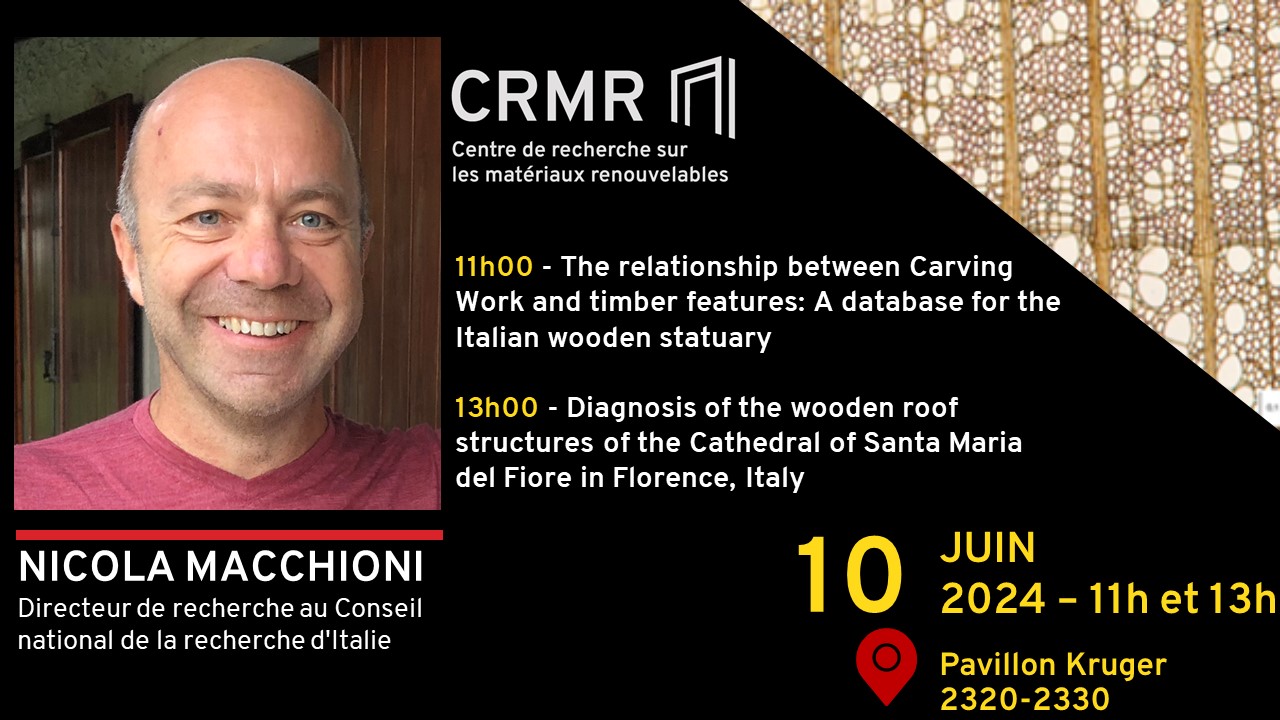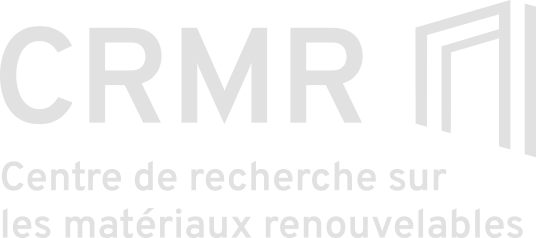Conférences de Nicola Macchioni, Directeur de recherche au Conseil national de la recherche d’Italie !
Le Centre de recherche sur les matériaux renouvelables vous convie à deux conférences présentées par Nicola Macchioni, Directeur de recherche au Conseil national de la recherche d’Italie (CNR), Institut de bioéconomie (IBE) à Sesto Fiorentino, et Chef du laboratoire de caractérisation anatomique du bois.
Les conférences auront lieu le 10 juin 2024 dans la salle 2320-2330 du Pavillon Gene-H.-Kruger de l’Université Laval, à Québec et seront en anglais.
La première conférence intitulée « The Relationship between Carving Work and Timber Features: A Database for the Italian Wooden Statuary», aura lieu le 10 juin 2024 à 11h.
La deuxième conférence intitulée « Diagnosis of the wooden roof structures of the Cathedral of Santa Maria del Fiore in Florence, Italy », se tiendra le 10 juin 2024 à 13h.

À propos du conférencier
Nicola Macchioni a obtenu son doctorat en sciences du bois de l’Université de Florence en 1992. De 1990 à 1994, il a été collaborateur externe à l’Université de Turin. En avril 1994, il a rejoint le Conseil national de la recherche d’Italie à l’Institut de technologie du bois de San Michele all’Adige. En 1997, il a été nommé chercheur permanent et chef du laboratoire d’anatomie du bois à l’Institut de recherche sur le bois (IRL) du Conseil national de la recherche d’Italie à Florence. En 2002, l’IRL est devenu l’Institut de l’arbre et du bois (IVALSA), puis a été intégré à l’Institut de bioéconomie en 2019. Depuis 2020, Nicola Macchioni occupe le poste de Directeur de recherche à l’Institut de bioéconomie du Conseil national de la recherche d’Italie à Sesto Fiorentino, où il est également chef du laboratoire de caractérisation anatomique du bois.
Il possède également une expérience dans l’enseignement, notamment en anatomie et en identification du bois. De plus, il est l’auteur de plus de 180 articles. Ses intérêts de recherche se concentrent sur la caractérisation anatomique du bois, avec un accent particulier sur son utilisation dans le patrimoine culturel. Il a mené des études approfondies sur diverses structures historiques en bois, notamment la cathédrale de Florence, le palais Ducal de Venise, le palais Corsini de Rome, le palais royal de Naples, l’église de la Nativité de Bethléem, la cathédrale de Mons en Belgique et le palais Benicarlò en Espagne. En tant que coordinateur du groupe rédigeant la norme EN sur les structures historiques en bois (EN 17121), il a joué un rôle crucial dans ce domaine. Ses recherches portent également sur le bois archéologique imprégné d’eau, en se concentrant sur le diagnostic de l’état de conservation et la caractérisation des traitements de consolidation. De plus, il explore les statues en bois en développant une base de données spécifique décrivant la relation entre le travail de sculpture et les différents types de bois.
Résumé des conférences
The Relationship between Carving Work and Timber Features: A Database for the Italian Wooden Statuary
« Wood has a wide range of applications in the artistic field, most of the time used as a support for works of art, for example, in panel paintings. Compared with stones and metals, wood is by far the material most utilised for sculptures. Through the identification of wood species, a study of timbers used in statuary in Europe, with a deeper exploration of the works of art preserved in Italy, can provide further insights for historical–artistic studies. Indeed, in reality, generic wood does not exist, but there are different timbers. This is a notion that the wood fine carving artists/craftsmen knew well. The initial idea of this study was to verify whether timber features could influence the formal results in figurative carving; therefore, a specific database that had been developed to catalogue the carving works was used for which the identification of wood species was carried out through reliable methodologies. The aim of this research was to analyse the relationship between the timber species used in statuary, the formal results of carving, and the thickness of the preparatory layer, through the data stored in a specific database, called ArISStArt. It contains a sort of registry of artistic carving and inlay works: For each artefact, a record was compiled consisting of different fields, which contains the historical–artistic information available, including the images of the artefact and also types of timber/s used for its creation, with a link to the relative field. The number of the recorded artefacts is, at present, 480. On most of the artefacts, more than one sample was taken; therefore, the total number of identifications carried out corresponds to 691. Based on the results, the vast majority of wooden statuary is carved from hardwoods, more specifically hardwoods, with diffuse porosity and small variations in density within the growth ring. The timber most present is poplar, followed by lime and walnut. With the listed three timbers, almost 80% of the artefacts recorded in ArISStArt were created.»
Diagnosis of the wooden roof structures of the Cathedral of Santa Maria del Fiore in Florence, Italy
«The construction of the cathedral of Florence, one of the largest churches in the world, demarks the typical skyline of the city with its huge dome. The construction began in 1296, while the church was consecrated in 1436. The considerable size of the church implies the usage of wooden structural elements that are dimensionally unique, originated from a forest in Italy that hardly finds similar examples. The importance of historical wooden structures, considered an integral part of the cultural heritage and memory, is also to be found in the safe use of the architectural asset. In 2020, a two-year project was launched, dedicated to the development of a protocol for the investigation of the wooden structure of the Cathedral roof, so to establish its state of conservation. The final aim is to proceed with a plan for a suitable restoration interventions and allow a correct restoration of the structures, thus guaranteeing a long-lasting service life of the building. The complete diagnostic followed the procedures described in the EN 17121:2019 standard. The results of the survey were elaborated and returned in tabular and graphical form to have a complete database, containing the information for each structural member and joint. On the basis of the results obtained, it was possible to carry out structural evaluations: structural analysis and verification, finite elements models of the stresses, structural assessment.The described results allow the managing body to estimate how and where to carry out any necessary intervention, fundamental for the maintenance and safety of the wooden structure and therefore, of the whole building»
Cet événement est organisé par le Centre de recherche sur les matériaux renouvelables en collaboration avec la professeure Tatjana Stevanovic Janezic. Pour toute question concernant l’événement, veuillez contacter Besma Bouslimi (besma.bouslimi@sbf.ulaval.ca).

